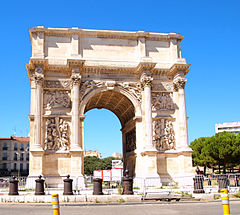Porte d'Aix
| Porte d'Aix | |
|---|---|

Porte d'Aix in Marseille, France
|
|
|
Location within Marseille
|
|
| General information | |
| Type | Royal triumphal arch |
| Location | Marseille, France |
| Coordinates | 43°18′06.45″N 05°22′29.15″E / 43.3017917°N 5.3747639°ECoordinates: 43°18′06.45″N 05°22′29.15″E / 43.3017917°N 5.3747639°E |
| Construction started | 1825 |
| Completed | 1839 |
| Design and construction | |
| Architect | Michel-Robert Penchaud |
Porte d'Aix (also known as the Porte Royale) is a triumphal arch in Marseille, in the south of France, marking the old entry point to the city on the road from Aix-en-Provence. The classical design by Michel-Robert Penchaud was inspired by the triumphal arches of the Roman Empire. The Porte d’Aix was initially conceived in 1784 to honour Louis XIV and to commemorate the Peace of Paris (1783) that ended the American war of independence. Following the restoration of the Bourbon monarchy in 1814-15, the project was resumed in 1823, now to commemorate French victories in the Spanish Expedition, notably at the Battle of Trocadero, August 31, 1823. It was eventually completed in 1839, with a more general theme of victory.
In 1660 Louis XIV descended on Marseille to bring order to a city in political turmoil. His troops blasted a hole in the old thirteenth century ramparts that ran the length of the rue d'Aix between the city gates of "Porte Royale" and "Porte d'Aix". Part of the subsequent reorganisation of Marseille involved not only an increased military presence, demolition of the old ramparts, new royal shipyards (Arsenal des Galères) and seaward fortifications, but also a new governing body drawn from the merchant class, charged with making plans to expand and beautify the city. From an early stage these plans included the reconstruction of the Porte Royale and the removal of the unsightly overground aqueduct (aqueduc de l'Huveaune) in the place d'Aix at the end of the rue d'Aix: the original porte d'Aix was formed by the arches of this aqueduct. Numerous projects for city plans were proposed, including one by Pierre Puget, placing a ceremonial Porte Royale in the place d'Aix.
...
Wikipedia

